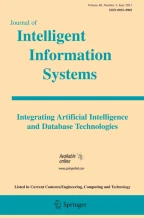Abstract
Prevention of drug dispensing errors is an importance topic in medical care. In this paper, we propose a risk management approach, namely Hybrid Data Mining (HDM), to prevent the problem of drug dispensing errors. An intelligent drug dispensing errors prevention system based on the proposed approach is then implemented. The proposed approach consists of two main procedures: First, the classification modeling and logistic regression approaches are used to derive decision tree and regression function from the given dispensing errors cases and drug databases. In the second procedure, similar drugs are then gathered together into clusters by combing clustering technique (PoCluster) and the extracted logistic regression function. The drugs that may cause dispensing errors will then be alerted through the clustering results and the decision tree. Through experimental evaluation on real datasets in a medical center, the proposed approach was shown to be capable of discovering the potential dispensing errors effectively. Hence, the proposed approach and implemented system serve as very useful application of data mining techniques for risk management in healthcare fields.
Similar content being viewed by others
Explore related subjects
Discover the latest articles, news and stories from top researchers in related subjects.References
Ashcroft, D. M., Quinlan, P., & Blenkinsopp, A. (2005). Prospective study of the incidence, nature and causes of dispensing errors in community pharmacies. Journal of Pharmacoepidemiology and Drug Safety, 14(5), 327–332.
Ben-Dor, A., Shamir, R., & Yakhini, Z. (1999). Clustering gene expression patterns. In Proc. of the annual international conference on computational molecular biology (pp. 281–297).
Cavell, G. F., & Oborne, C. A. (2001). Anonymously reported medication errors: The tip of the iceberg. The Internal Journal of Pharmacy Practice, 9(suppl), R52.
Chua, S. S., Wong, I. C., et al. (2003). A feasibility study for recording of dispensing errors and near misses’ in four UK primary care pharmacies. Drug safety, 26(11), 803–813.
Ester, M., Kriegel, H. P., Sander, J., & Xu, X. (1996). A density-based algorithm for discovering clusters in large spatial databases with noise. In Proc. of the international conference on knowledge discovery and data mining (pp. 226–231).
Gadd, T. N. (1990). PHONIX: The algorithm. Program: Automated Library and Information Systems, 24(4), 222–237.
Hall, P. A. V., & Dowling, G. R. (1980). Approximate string matching. Computing Surveys, 12(4), 381–402.
Kaufman, L., & Rousseeuw, P. J. (1990). Find groups in data: An introduction to cluster analysis. New York: Wiley.
Kenagy, J. W., & Stein, G. C. (2001). Naming, labeling, and packaging of pharmaceuticals. American Journal of Health-System Pharmacy, 58(21), 2033–2041.
Kistner, U. A., Keith, M. R., Sergeant, K. A., & Hokanson, J. A. (1994). Accuracy of dispensing in a high-volume, hospital-based outpatient pharmacy. American Journal of Hospital Pharmacy, 51(22), 2793–2797.
Kohn, C. D. (1999). To error is human: Building a safer health system. New York: National Academy.
Kondrak, G. (2000). A new algorithm for the alignment of phonetic sequences. In Proc. of the NAACL-2000: First meeting of the North American chapter of the association for computational linguistics (pp. 288–295).
Lambert, B. L., Lin, S. J., Chang, K. Y., & Gandhi, S. K. (1999). Similarity as a risk factor in drug-name confusion errors: The look-alike (orthographic) and sound-alike (phonetic) model. Med Care, 37(12), 1214–1225.
Lazarou, J., Pomeranz, B. H., & Corey, P. N. (1998). Incidence of adverse drug reactions in hospitalized patients. Journal of the American Medical Association, 279, 1200–1205.
Liu, J., Zhang, Q., Wang, W., McMillan, L., & Prins, J. (2006). Clustering pair-wise dissimilarity data into partially ordered sets. In Proc. of the international conference on knowledge discovery and data mining (pp. 637–642).
Long, G., & Johnson, C. (1981). A pilot study for reducing medication errors. QRB Quality review bulletin, 7(4), 6–9.
McEnery, A., & Oakes, M. P. (1996). Sentence and word alignment in the CRATER project: Methods and assessment. In J. Thomas, & M. Short (Eds.), Using corpora for language research (pp. 211–231). London: Longman.
McQueen J. B. (1967). Some methods of classification and analysis of mutivariate observations. In Proc. of the 5th Berkeley symposium on mathematical satistics and probability (pp. 281–297).
Melamed, D. I. (1999). Bitext maps and alignment via pattern recognition. Computational Linguistics, 25(1), 107–130.
Peterson, G. M., Wu, M. S., & Bergin, J. K. (1999). Pharmacists attitudes towards dispensing errors: Their causes and prevention. Journal of Clinical Pharmacy and Therapeutics, 24(1), 57–71.
Rudman, W. J., et al. (2002). The use of data mining tools in identifying medication error near misses and adverse drug events. Topics in Health Information Management, 23, 94–101.
Tseng, V. S., & Kao, C. P. (2005). Efficiently mining gene expression data via a novel parameterless clustering method. The IEEE/ACM Transactions on Computational Biology and Bioinformatics, 2(4), 355–365.
Tseng, V. S., Chen, C. H., Chen, H. M., Chang, H. J., & Yu, C. T. (2007). Using data mining techniques for analysis and prevention of dispension errors. In Proc. of the int’l workshop on computational intelligence on biomedical engineering (held with IEEE BIBE’07) (pp. 65–70).
Tuohy, N., & Paparella, S. (2005). Look-alike and sound-alike drugs: Errors just waiting to happen. Journal of Emergency Nursing, 31(6), 569–571.
Ukkonen, E. (1985). Finding approximate patterns in strings. Journal of Algorithms, 6, 132–137.
Wagner, R. A., & Fischer, M. J. (1974). The string-to-string correction problem. Journal of the ACM, 21(1), 168–173.
Witten, I. H., & Frank, E. (2005). Data mining: Practical machine learning tools and techniques (2nd ed.). San Francisco: Kaufmann.
Acknowledgements
This research was supported by National Science Council, Taiwan, R.O.C., under grant number NSC 96–2221-E-006 -143 -MY3 and NSC 97–3114-E006–001.
Author information
Authors and Affiliations
Corresponding author
Rights and permissions
About this article
Cite this article
Chen, LC., Chen, CH., Chen, HM. et al. Hybrid data mining approaches for prevention of drug dispensing errors. J Intell Inf Syst 36, 305–327 (2011). https://doi.org/10.1007/s10844-009-0107-6
Received:
Revised:
Accepted:
Published:
Issue Date:
DOI: https://doi.org/10.1007/s10844-009-0107-6
